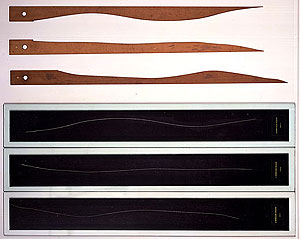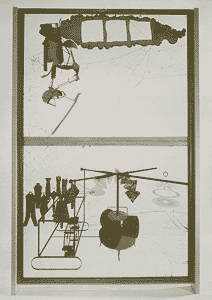|
Pata or Quantum: Duchamp and the End of Determinist Physics by Jonathan Williams |
||||||||||
|
The early 20th Century
saw a breakdown, a deconstruction if you will, of the classical Enlightenment
assertion that the world is fundamentally knowable to us. In the art
and philosophy of the Enlightenment era, the rational capacity of the
human mind to analyze and comprehend itself and the world was trusted
implicitly. In science, the classical Newtonian physical model was the
dominant paradigm. This model held that given sufficient knowledge of
a physical system's initial state, its behavior could be understood
and predicted completely. Everything in the world that was hidden or
obscured could in theory be explained and brought to light by the proper
application of human reasoning. But beginning with mathematical thinking
in geometry done in the 1860s, these enlightenment ideals began to lose
their hold on the world of ideas. Work done in physics, psychology and
art began to reformulate a picture of reality that was less certain,
and involved more risks. The scientific groundwork for some of Duchamp's ideas in these works comes from investigations of non-Euclidean geometries, concepts of 4th dimensional space, work done on x-rays, radiation, and electro-magnetism. Later developments in science, especially the foundations of modern quantum mechanics, continue the trend of less deterministic ways of viewing reality, almost re-iterating some of Duchamp's playful science fiction as science fact. The Heisenberg Uncertainty Principle contextualizes scientific measurement, considering the impact of the viewer on the object being viewed, and introduces an irreducible uncertainty as to the exact energy states of basic particles. Erwin Schrödinger's set of quantum equations (which links the particle/wave behaviors of electrons, photons, and other particles) expresses their movements in terms of statistical probability fields, such that it becomes meaningless to talk of the particle as having a distinct position at any given time. This breaking down of assumptions concerning the predictable, rational behavior of the world in Duchamp's work and in the sciences shares traits with several movements that emerged in and around World War I. Groups like the Cubists, the Futurists and the Dadaists shared a mission of transforming perceptions of the world in order to change how people relate to the world. While it can be difficult to interpret the true intent of the (often contradictory) manifestos and performances of the Dada group, we may try to deduce some valuable structures from their story. Rebelling against the rationalist social structures responsible for the devastating war, Dadaists attempted to create new languages for artistic (or even anti-artistic) expression. The Dada project recognized the inadequacies of existing forms of expression to compass a real understanding of the changing world, and sought to destroy all rationalistic cultural norms in art. By satirizing, mimicking, and distorting the systems they attacked, the Dadaists may have sought to demonstrate the inadequacies of their targets and point the way to the possibility of better forms. In a way, the Dadas acted as a sort of social resistor, slowing down the cultural machinery of the time, helping to re-orient society in a different direction. Duchamp, who is often seen as a sort of cultural father to the Dadaists, had a large impact on this cultural resistance that has been extensively researched and discussed. But the scientific inquiry in his pataphysics and the ways it might be seen as an antecedent to current thinking in quantum physics has not been adequately explored. The word "pataphysics" was first introduced in 1893 by playwright Alfred Jarry who was attempting to create what he called a "science of imaginary solutions." As historian Linda Henderson explains, "Jarry was deeply interested in contemporary developments in science and geometry, which offered a means to challenge traditional positivism" (Henderson, 47). One of these developments was the mathematical description of non-Euclidean geometries. Classical geometry, as first formulated by Euclid in Alexandria circa 300 BCE, has within it the fundamental assumption that two parallel lines will extend indefinitely and never meet. This assumption was held to be a priori fact until work done by Carl Friedrich Gauss, Georg Riemann, and others around the 1860s pointed the way toward internally consistent geometrical systems that behaved very differently from the classical model. While working in a Paris library in the early 1910s, Duchamp was exposed to the writing of French mathematician Henri Poincare, whose writings in support of the new mathematical models against the Enlightenment traditions of classical rationalism were an inspiration to him.
The work that most exemplifies Duchamp's interest in non-Euclidean geometries (with its implications of non-intuitive curved spaces) is 3 Standard Stoppages of 1914. Duchamp describes the piece in a questionnaire from the Museum of Modern Art as "a joke about the meter - a humorous application of Riemann's post Euclidean geometry which was devoid of straight lines" (Henderson, 61). As with all of Duchamp's work, this art object functions on several different levels simultaneously. The object itself consists of three pieces of wood cut to the pattern of a length of string which Duchamp claims to have dropped three times, so the resulting pattern is a random distortion of a straight line. Recent investigations of this crucial work also point out the nature of the French 'stoppage' or 'invisible mending' in relation to small alterations the artist made to the supposedly random shape. Most of Duchamp's work contains an element of social parody or satire, and 3 Standard Stoppages is no exception. France at the time considered itself to be an arbiter of European High culture, and also acted as the official organ of the relatively recent metric system. By creating a new standard of measurement based on chance, Duchamp lampoons the French national pride in its standard measurement. The Standard Stoppages also represent a major investment in the use of chance as an expressive medium (the piece is sub-titled "Canned chance, 1914"). But there is a deeper element to the proclamation Duchamp makes with the Stoppages, which becomes manifest in the Large Glass. The Stoppages stand as the foundation of the fictional physical system that Duchamp describes in the notes of the Green Box, and diagrams in the Large Glass. He decisively breaks away from the classical, rationalist physical model and determines a new fundamental unit for his new science. Duchamp refers to
Jarry's ideas and consciously speaks about his desire to re-invent the
physical model of the time when he describes the Stoppages as
"casting a pataphysical doubt on the concept of the straight line as
being the shortest route from one point to another" (Henderson, 62).
He states in his notes that he is interested in describing "a reality
which would be possible by slightly distending the laws of physics and
chemistry," (Henderson, xix) and the original Stoppages represent
a fundamental unit of that distension. Rather like Planck's constant
in quantum mechanics, or the speed of light in General Relativity, the
Stoppages represent a new basic metric for describing and measuring
the profoundly irrational space that is described in The Bride Stripped
Bare by Her Bachelors, Even. This relationship is evident in the
placement of a Network of Stoppages in the Large Glass, a pataphysical
device that carries the spray of the Bachelor Machine to the sieves
and parasols. He places the new metric directly into the system, using
his measuring device to transport the erotic energy of the Bachelors.
The Bride Stripped
Bare by Her Bachelors, Even is a modern day chimera, with almost
as many interpretations as it has had viewers. In some sense, though,
it can be called a pataphysical system that makes a "…critique of scientific
laws and determinist causality" (Henderson, 185). Duchamp incorporates
many different scientific ideas of his time into the workings of the
piece, and had been exploring these ideas for some time. Beginning with
the Cubists and their exploration of Bergsonian ideas of simultaneity,
Duchamp also worked with the evolving notions of fourth dimensional
space and X-ray exploration of previously hidden realities. His ideas
of the experience of time went into his Nude Descending a Staircase,
No. 2 in 1912. Although he started work in this vein under the auspices
of the Cubists (including his brothers, artists Jacques Villon and Raymond
Duchamp-Villon) the execution of the Nude proved too radical
for the Cubists, and Duchamp subsequently declared he was through with
art "Movements." From there, Duchamp explores even further his ideas
of 4th dimensional space in his series of studies of the Bride figure.
The forces that Duchamp explores in his work are invisible, obscured. His interest in x-rays, radio waves, and magnetism inform and give shape to his pataphysics, as they also define the trends in physical sciences discussed here. The psychoanalytic theories of Freud and Jung that were so terribly influential on European and American artists of the time emphasize the hidden aspects of the personality; the subconscious is that which cannot be known or experienced by us directly but has a substantial impact on our actions and who we believe ourselves to be. There was at the time a confluence of thought accepting the existence of hidden mysteries with the intent to explore their boundaries. Gabriel Buffet Picabia characterized the 1910s as a time of "an ebullience of invention, of exploration beyond the rational in every domain of the mind- science, psychology, imagination.… It would seem, moreover, that in every field, a principle direction of the 20th century was the attempt to capture the 'non-perceptible'"(Henderson, XX). It is unlikely that Duchamp's work had any direct influence on the scientists working in the areas that I have described, but the current of thought that has been carried through in so many ways through so many different permutations has had a profound impact on how we view the world around us. The complexities of Marcel Duchamp's thought and the rich history behind the development of indeterminate quantum physics deserve far more attention than I have been able to give them here. It would be valuable to invest more attention into the roots of the Enlightenment ideals I have referred to, and to explore the reactions of the guardians of the Enlightenment ideals to early 20th century doubts. Further investigation of Duchamp's notion of "unloading" ideas from objects and systems that he explored in the readymades warrants further investigation, to see the effect of his unloading in scientific gestalt of the era. The chaos mathematics that has become such a powerful way to investigate patterns in seemingly random behaviors may have some very interesting parallel ideas to some of those presented here. This essay only scratches the surface of many relevant topics. But the exercise of examining the ideas from the different disciplines I've touched on (art, science, and psychology) seems a very productive one, and the similarities and differences in the conceptions of the world help enrich our understanding of ourselves and how we have come to believe the things we believe. Sources Henderson, Linda Dalrymple. Duchamp in Context, Princeton University Press, 1998
|
||||||||||













